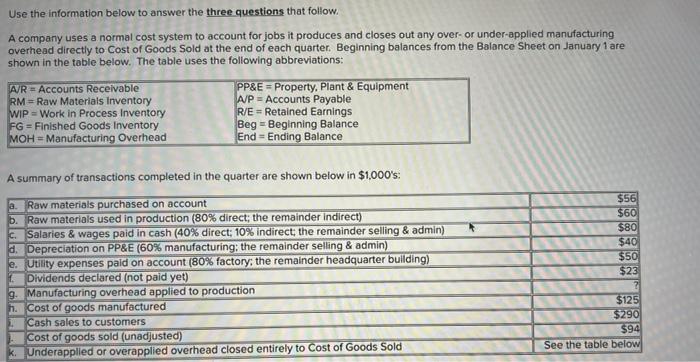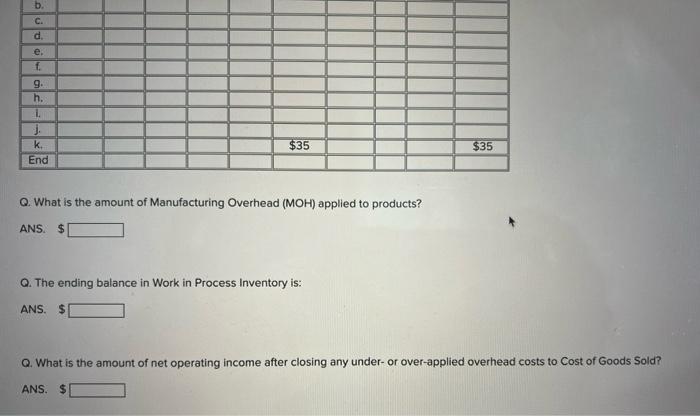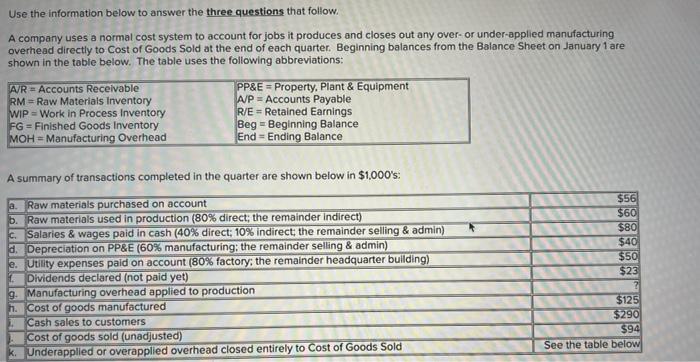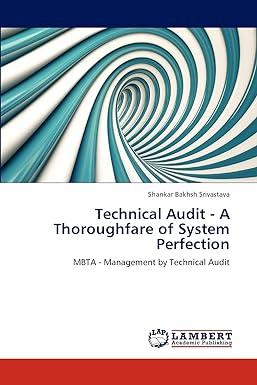Use the information below to answer the three questions that follow. A company uses a normal cost system to account for jobs it produces and closes out any over- or under-applied manufacturing overhead directly to Cost of Goods Sold at the end of each quarter. Beginning balances from the Balance Sheet on January 1 are shown in the table below. The table uses the following abbreviations: A/R = Accounts Receivable RM=Raw Materials Inventory WIP = Work in Process Inventory FG = Finished Goods Inventory MOH = Manufacturing Overhead PP&E = Property. Plant & Equipment A/P = Accounts Payable R/E = Retained Earnings Beg Beginning Balance End Ending Balance A summary of transactions completed in the quarter are shown below in $1.000's. a. Raw materials purchased on account b. Raw materials used in production (80% direct; the remainder indirect) C. Salaries & wages paid in cash (40% direct: 10% indirect; the remainder selling & admin) d. Depreciation on PP&E (60% manufacturing: the remainder selling & admin) e. Utility expenses paid on account (80% factory, the remainder headquarter building) Dividends declared (not paid yet) 9. Manufacturing overhead applied to production h. Cost of goods manufactured Cash sales to customers Cost of goods sold (unadjusted) k. Underapplied or overapplied overhead closed entirely to Cost of Goods Sold $56 $60 $80 $40 $50 $23 $125 $290 $94 See the table below b. C. d e. f 9. h. 1 J. k. End $35 $35 Q. What is the amount of Manufacturing Overhead (MOH) applied to products? ANS $ Q. The ending balance in Work in Process Inventory is: ANS. $ Q. What is the amount of net operating income after closing any under-or over-applied overhead costs to Cost of Goods Sold? ANS. $ Use the information below to answer the three questions that follow. A company uses a normal cost system to account for jobs it produces and closes out any over- or under-applied manufacturing overhead directly to Cost of Goods Sold at the end of each quarter. Beginning balances from the Balance Sheet on January 1 are shown in the table below. The table uses the following abbreviations: AVR = Accounts Receivable RM=Raw Materials Inventory WIP = Work in Process Inventory FG = Finished Goods Inventory MOH = Manufacturing Overhead PP&E = Property. Plant & Equipment A/P = Accounts Payable R/E = Retained Earnings Beg - Beginning Balance End Ending Balance A summary of transactions completed in the quarter are shown below in $1.000's: a. Raw materials purchased on account b. Raw materials used in production (80% direct; the remainder indirect) C. Salaries & wages paid in cash (40% direct: 10% indirect: the remainder selling & admin) d. Depreciation on PP&E (60% manufacturing: the remainder selling & admin) e. Utility expenses paid on account (80% factory, the remainder headquarter building) Dividends declared (not paid yet) 9. Manufacturing overhead applied to production h. Cost of goods manufactured Cash sales to customers Cost of goods sold (unadjusted) k. Underapplied or overapplied overhead closed entirely to Cost of Goods Sold $56 $60 $80 $40 $50 $23 $125 $290 $94 See the table below









